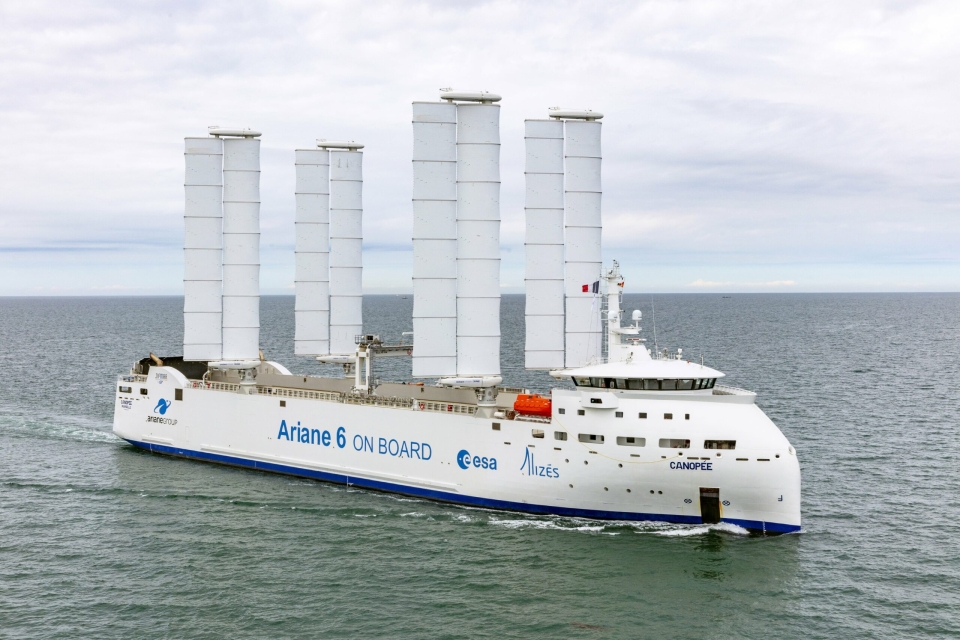The sailing freighter Canopée can finally start using the power of the wind now that it has been equipped with four Ayro masts and Oceanwings sails. The 121-metre, 10,699-GT RoRo vessel, designed to carry rocket parts from Europe to South America, was launched in Poland late last year, but had yet to receive its sails.
Neptune Marine in Hardinxveld-Giessendam, the Netherlands, was responsible for building the Canopée, with Groot Ship Design supplying the naval architectural works and all engineering for steel construction and information for processing the plates and profiles. The vessel was largely built at the Partner Stoczina shipyard in Szczecin, Poland, where it was launched on 28 June 2022. It then arrived in the Netherlands in October to be completed at Neptune.
At the start of the year, Bolloré Logistics organised the door-to-door transport of a satellite and its various components from the customer’s site in Toulouse to the Guiana Space Centre in Kourou. Weighing 42 tonnes in total, the Canopée transported the load over nearly 7000 km during a three-week period. It was the Canopée’s first transatlantic crossing.
Also read: Canopée makes first Atlantic crossing for Bolloré
Oceanwings
Yet, the 121-metre-long ship was designed to be equipped with four 30-metre-high Oceanwings, which were finally placed on board at the end of July. The Oceanwings 363 sail panels cover an area of 363 square metres each and should save around 35 per cent on fuel consumption.
AYRO’s patented Oceanwings are said to be suitable for most vessel types, new build and retrofit, with easy and quick integration. The system does not require skills traditionally needed to sail. The system involves a reefable and auto moved wingsail, that can run under a large range of wind angles and strengths.
The wings consist of two flaps, one forward and one aft. These wings allow two main adjustments. Firstly, the angle of incidence of the wings, which turn 360 degrees in relation to the wind and the rear flap, which can pivot around the secondary mast to create a camber in relation to the front flap. The wings generate more power than conventional sails or single-element wings.
Gurit European & New Zealand Engineering teams collaborated with Ayro for the development of the Oceanwings 363. Gurit provided composite structural engineering support for the main and secondary mast, as well as the boom and the crane.
Also read: VIDEO: Sailing freighter Canopée leaves Neptune yard for sea trials
Transporting rockets
Alizés, which means trade winds, is a joint venture between the French shipping companies Jifmar Offshore Services and Zéphyr et Borée set up especially for this project. It won the Ariane Group’s tender a year ago for a new transport concept, beating among others the large French shipping company Louis Dreyfus Armateurs.
Canopée’s structure has been specially designed to transport containerised sections of Ariane 6 launchers. The vessel will transport Ariane rockets from Europe to French Guyana. As such, it has been specifically designed to be able to navigate upriver at Kourou, right to the dock near the Spaceport.
Also read: Sailing freighter Canopée reaches Netherlands to be completed at Neptune
Canopée particulars
The Canopée is an open top RoRo ship. The ship has a lot of deck area and a limited draught. The most visible innovation are the four Oceanwings on the ship. This creates a propulsion force to reduce fuel consumption and thus CO2, NOx and SOx emissions.
The details according to Neptune Marine are:
- Length: 121.00 m
- Width: 22.00 m
- Design draught: 4.30 m
- Scantling draught: 5.00 m
- River draught: 3.80 m
- Deadweight (5.00 m): 5500 t
- Deadweight river: 2700 t
- Tank top surface: 655 m2
- Surface mezzanine deck (3 removable panels 335 m2)
- Design speed: 16.5 kn
- Main engines: 2 x 3480 kW
- Oceanwings: 4x 363 m2
- Accomodation: 22 people (11 crew members)
Picture (top) by Neptune Marine.








